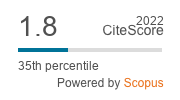Allosteric Regulation of the Photosynthetic C4 Isoenzyme of Phosphoenolpyruvate Carboxylase: A Comparative Study Between Enzymes from Monocot and Dicot Plants
DOI:
https://doi.org/10.29356/jmcs.v56i1.275Keywords:
Zea mays L., Amaranthus hypochondriacus L, C4 metabolism, allosteric activation, allosteric inhibition, amino acid sequence alignment, three-dimensional homology modelAbstract
In the present study, we have investigated the complex allosteric regulation of the non-phosphorylated forms of the photosynthetic phosphoenolpyruvate carboxylase isoenzymes (PEPC-C4) from amaranth (AhPEPC-C4) and maize (ZmPEPC-C4) leaves. Previous studies showed that glycine (Gly) only activates PEPC-C4 from monocot plants, as maize, but not from dicot plants, as amaranth. Our initial velocity data confirm this, in spite that AhPEPC-C4 binds Gly with much higher affinity than ZmPEPC-C4. In AhPEPC-C4, the lack of Gly activation is overcome mainly by its higher affinity for the substrate phosphoenolpyruvate and its lower affinity for the inhibitor malate compared with ZmPEPC-C4. We have also explored the structural determinants of the differences in Gly activation by performing multiple alignments between the known monocot and dicot PEPC-C4 sequences and by modeling, in both the AhPEPC-C4 and ZmPEPC-C4 isoenzymes, the three-dimensional structure of the loop proposed as the Gly binding site, which was not observed in the crystal structure of the maize enzyme due to its high flexibility. The models suggest that conserved lysyl and aspartyl residues are important for binding to the activator molecule, and that a nearby non-conserved residue may be responsible for differences between the amaranth and maize enzymes in the loop conformation, which would account for the poorer affinity for Gly of the maize enzyme as well as for its higher degree of activation.Downloads
Downloads
Published
Issue
Section
License
Authors who publish with this journal agree to the following terms:
- Authors retain copyright and grant the journal right of first publication with the work simultaneously licensed under a Creative Commons Attribution License that allows others to share the work with an acknowledgement of the work's authorship and initial publication in this journal.
- Authors are able to enter into separate, additional contractual arrangements for the non-exclusive distribution of the journal's published version of the work (e.g., post it to an institutional repository or publish it in a book), with an acknowledgement of its initial publication in this journal.









